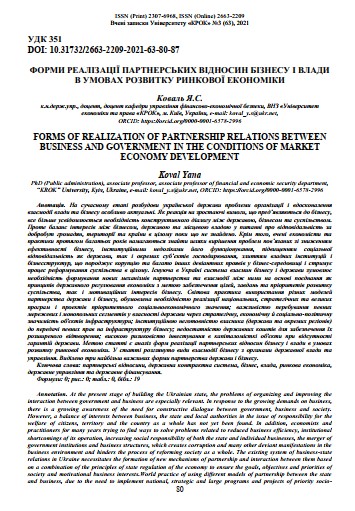FORMS OF REALIZATION OF PARTNERSHIP RELATIONS BETWEEN BUSINESS AND GOVERNMENT IN THE CONDITIONS OF MARKET ECONOMY DEVELOPMENT
DOI:
https://doi.org/10.31732/2663-2209-2021-63-80-87Keywords:
partnerships, public contract system, business, government, market economy, public administration and public fundingAbstract
At the present stage of building the Ukrainian state, the problems of organizing and improving the interaction between government and business are especially relevant. In response to the growing demands on business, there is a growing awareness of the need for constructive dialogue between government, business and society. However, a balance of interests between business, the state and local authorities in the issue of responsibility for the welfare of citizens, territory and the country as a whole has not yet been found. In addition, economists and practitioners for many years trying to find ways to solve problems related to reduced business efficiency, institutional shortcomings of its operation, increasing social responsibility of both the state and individual businesses, the merger of government institutions and business structures, which creates corruption and many other deviant manifestations in the business environment and hinders the process of reforming society as a whole. The existing system of business-state relations in Ukraine necessitates the formation of new mechanisms of partnership and interaction between them based on a combination of the principles of state regulation of the economy to ensure the goals, objectives and priorities of society and motivational business interests.World practice of using different models of partnership between the state and business, due to the need to implement national, strategic and large programs and projects of priority socio-economic importance; the importance of the existence of certain network and monopoly segments in state ownership due to the strategic, economic and socio-political significance of infrastructure facilities; institutional unwillingness of the owner (state and individual regions) to transfer certain rights to business infrastructure; lack of public funds to ensure their expanded reproduction; high risk of investing in capital-intensive facilities in the absence of state guarantees. The purpose of the article is to analyze the forms of partnership between business and government in a market economy. The article considers the types of business interaction with public authorities and administration. The three most important forms of partnership between the state and business are identified.
Downloads
References
Уманець Т. Інформаційно-аналітична база регіонального управління: сучасний стан та перспективи розвитку. Економіка України. 2013. № 8. С. 39-45.
Федорович В. А., Патрон А. П. США: государство и экономика (Институт США и Канады РАН). Москва : Международные отношения. 2010. 386 с.
Карпець C. JI. Агентства регіонального розвитку: європейський досвід, практика становлення та перспективи розвитку в Україні. Формування ринкових відносин в Україні. 2013. № 7.С. 131-142.
Варнавский В. Г. Партнерство государства и частого сектора: Теория и практика. Мировая экономика и международные отношения. 2012. № 7 С. 28-37.
Державне управління та державна служба: словник-довідник / уклад. О. Ю. Смоленський. Київ : КНЕУ, 2005. 480 с.
Адамов Б. І., Діденко Н. Г. Вплив державного управління на формування інформаційної відкритості як основи соціального партнерства в українському суспільстві. Управління діяльністю органів державної влади. Серія «Державне управління». 2016. T.VII. Вип. 71. С. 94-104.
Бодров В. Г. Трансформація економічних систем: концепція, моделі, механізми регулювання та управління: навч. посіб. Київ : УАДУ, 2012. 104 с.
Антонов В. В. Методологічні підходи щодо оцінки рівня соціально-економічного розвитку регіонів України. Управління сучасним містом. 2013. № 7. С. 51-61.
Балюк М., Гончарова Г. Зміни в організації виробництва і праці та соціальне партнерство. Право України. 1996. № 11. С. 33-37.
Барр Р. Политическая экономия. Москва : Междунар. отношения : в 2-х т. 1995. Т. 1. 608 с.
Геєць В. М. Характер перехідних процесів до економіки знань. Економіка України. 2013. № 4. С. 4-14.
Безверхнюк Т. М., Топчієв О., Тітенко З. Державне управління на регіональному рівні та державне регулювання регіонального розвитку: змістовне наповнення й ресурсне забезпечення. Теорія та практика державного управління. 2016. Вип. 3.С. 146-153.
Юрченко О. С., Трохимченко М. Теоретико-методологічні положення розвитку регіональної політики. Економіка і регіон. 2013. № 2. С. 59-62.
Бендиков М. А., Фролов И. Инновационный потенциал и модернизация экономики: отечественный и зарубежный опыт. Менеджмент в России и за рубежом. 2013. № 1. С. 17-37.
Хмельников А. Напрями вдосконалення управління економічною сферою регіону. Актуальні проблеми державного управління. 2016. Вип. 2. С. 122-128.
Вахович І. М. Фінансова політика сталого розвитку регіону: методологія формування та механізми реалізації : монографія. Луцьк: Надстир’я, 2007. 496 с.
Бережная И. В., Стефанюк О. Д. Типология регионов, как основной аспект регионалистики. Экономика и управление. 2013. № 2. С. 81 -86.
Студенніков І., Ткаченко В. Інституційна інфраструктура регіонального розвитку в Україні : сучасний стан і проблеми формування. Економічний часопис. 2017. № 9. С. 36-40.
Благун І. С., Солтисік О. О. Моделювання стратегій розвитку регіону. Регіональна економіка. 2018. № 4. С. 105- 111.



